One of the key components in mushers’ Iditarod strategies is where they opt to take their mandatory 24 hour rests. Some declare it early in McGrath. Others push up to Takotna, and a bold few push their luck driving their teams toward Ophir and all the way to Iditarod, the race’s midpoint.
Alaska Public Media’s Zachariah Hughes looks at two very different options – Takotna and Ophir – to find out what considerations mushers are weighing when they opt to sit still for a whole day.
Generally the most popular checkpoint to 24 is Takotna, renowned for its hospitality, comfortable accommodations, and pies. It’s also extremely well set-up for a long-term stay, with dog-teams parked up and down a roomy hillside that’s out of the way of foot traffic and snowmachines.
Linwood Fiedler says it’s just more comfortable than the other options up or down the trail.
“Well, you certainly get better fed here; you don’t have to make your own food, which is nice. And the community is so supportive here. Water for your dogs is so easy. So, there’s a lot of creature comforts here.”
There’s also a decent set-up for sleeping in the community’s small church, some of the first real rest in days for many racers.

Takotna is also well positioned strategically. For mushers planning out moves three and four steps ahead, like Cody Strathe, the town is an excellent launching point for the austere runs on the way to the Yukon River.
“Right when you leave here, it’s precisely 100 miles to Iditarod. So, that’s a good distance to split in half for your first start. You don’t want to do mega runs, so you do two, 50-mile runs. Conveniently, there’s a shelter cabin 50 miles in, so you don’t even have to sleep on the ground. So, once you get to Iditarod, it’s roughly another 50 miles to Shageluk and so on, and it kind of sets you up perfectly for getting out of here, if you were to stay.”
And there’s camaraderie in Takotna. Mushers sit shoulder to shoulder with one another at a table in the bustling community center, where hot meals are dished out. Strathe says that, mentally, there’s a little boost from getting to talk with other mushers and comparing notes.
“It’s nice to have some conversations and see that other people are going through the same things.”

“Takotna’s really easy and comfortable, but it’s just really busy, so it just seems like the dogs rest better here ‘cause there’s not so many people.”
Anna Berington made it to Ophir before declaring her 24. And even though it’s only about two dozen miles away, compared to Takotna, it feels like a semi-abandoned wilderness outpost. Which, it sort of is. There’s a small hunting cabin surrounded by some outbuildings. Nobody lives in Ophir; it’s more like a landmark than a town. Mushers can sleep in a wall tent, or, if you’re Martin Buser, you’ve got a backup strategy.
“I have my tent with me, too. If it gets crowded, I’ll just whip out my tent and call it a privacy trip.”
Buser is mixing up a meal for his team, dropping chunks of frozen pre-cut meat into a bucket with kibble. Even though there are some snowmachines zooming by, and the whir of a pesky drone as it buzzes overhead, he’s made Ophir a frequent destination for his 24 because of the quiet. He says it makes better rest for the dogs. And while it’s nice being fed, his wife packs him plenty of high-quality trail meals that he prefers.
“Shrimp. Steak. Peas. Corn. Poppy seed muffins. I have a little bit of everything in every checkpoint.”
As for the other creature comforts he’s forgoing in Ophir, Buser says he thought that was the whole point of the Iditarod.
“Well it’s a dog race, ya know… I guess that’s what we’re supposed to be doing. That’s what I expected to do when I started the race.”
Once mushers come off their 24s they have another mandatory rest for 8 hours they can take at any checkpoint along the Yukon, and another one in White Mountain 77 miles from Nome.
Image at top: Jeff King resting his team at the Ophir checkpoint. Photo: Zachariah Hughes, Alaska Public Media.








